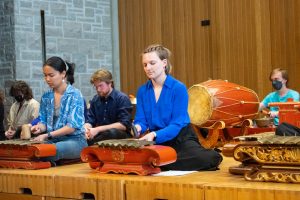 The St. Olaf Javanese Gamelan Ensemble was established in 2019 after Mary Shamrock (‘58) generously donated the instruments to the College. A gamelan consists of a large number of bronze gongs and metallophones of different sizes, a set of drums, as well as elaborating instruments such as a zither, a bowed fiddle, and a flute. Each set of instruments receives an individual name — the St. Olaf set, first commissioned by Shamrock, is Gamelan Kyai Kumbul, with “kumbul” meaning “growth.” The Ensemble Director, Assistant Professor of Music Rehanna Kheshgi, is also performing member of Sumunar Gamelan Ensemble in St. Paul. In addition to directing the St. Olaf Javanese Gamelan Ensemble, Dr. Kheshgi offers an annual course on Javanese Gamelan history, aesthetics, culture and performance practice. Joko Sutrisno, the Director of Sumunar Gamelan Ensemble, has also contributed in important ways to the establishment of the St. Olaf Javanese Gamelan Ensemble through workshops, guidance, and participating in performance alongside student members.
The St. Olaf Javanese Gamelan Ensemble was established in 2019 after Mary Shamrock (‘58) generously donated the instruments to the College. A gamelan consists of a large number of bronze gongs and metallophones of different sizes, a set of drums, as well as elaborating instruments such as a zither, a bowed fiddle, and a flute. Each set of instruments receives an individual name — the St. Olaf set, first commissioned by Shamrock, is Gamelan Kyai Kumbul, with “kumbul” meaning “growth.” The Ensemble Director, Assistant Professor of Music Rehanna Kheshgi, is also performing member of Sumunar Gamelan Ensemble in St. Paul. In addition to directing the St. Olaf Javanese Gamelan Ensemble, Dr. Kheshgi offers an annual course on Javanese Gamelan history, aesthetics, culture and performance practice. Joko Sutrisno, the Director of Sumunar Gamelan Ensemble, has also contributed in important ways to the establishment of the St. Olaf Javanese Gamelan Ensemble through workshops, guidance, and participating in performance alongside student members.
From early Hindu-Buddhist roots, Javanese Gamelan developed and flourished as an art-music and dance tradition in the royal courts of Java, one of the many islands in Indonesia. Some Javanese Gamelan pieces are stand-alone musical pieces, while other pieces incorporate both music and dance. Some pieces are designed to accompany shadow puppet theater, which incorporates stories from the Hindu epics Mahabharata and Ramayana, and are often performed for Islamic ceremonial occasions in Java. The Gamelan tradition offers an example of interconnectedness between different religious philosophies in Indonesia through music, dance, and theater. This interconnectedness is also felt by the members of the ensemble who depend on each other since it is impossible to perform this music alone. The different musical instruments that make up the ensemble each contribute on a structural, melodic, or elaborative level to create an integrated whole. This relationship has been compared metaphorically to a tree, with structure-holding instruments as roots, melodic instruments as the trunk, and elaborating instruments as the branches and leaves.